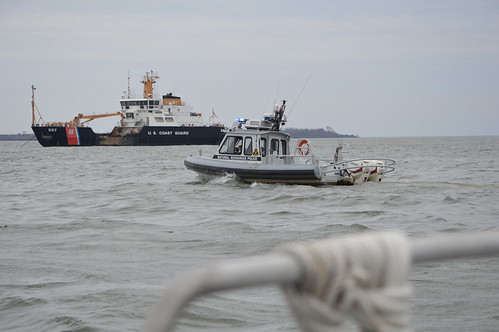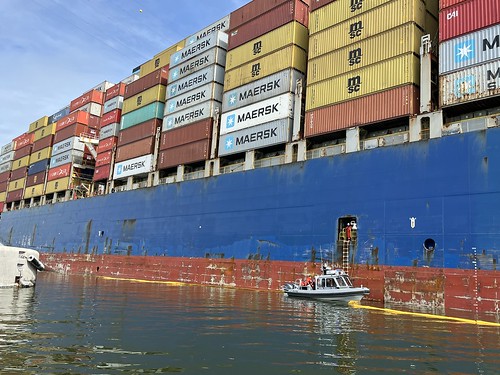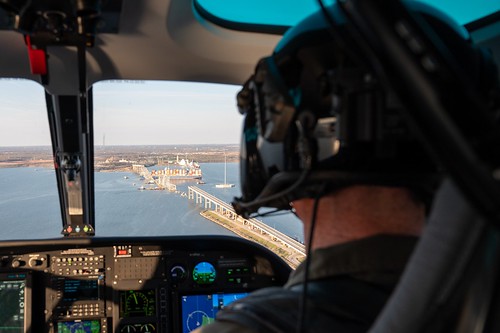
NRP patrol vessels establish a 2,000-yard safety zone around the wreckage of the Key Bridge. Department of Natural Resources photo.
The Maryland Natural Resources Police (NRP) has been an integral part of the multi-agency response to the collapse of the Francis Scott Key Bridge after it was struck by a container ship on March 26.
During the initial response, NRP officers assisted with above- and below-water search and recovery operations, aerial reconnaissance, and safety zone enforcement. Now one month removed from the disaster, NRP officers continue extended patrol of the safety zone, monitor traffic in temporary channels, and assist with transporting political officials and members of joint allied agencies to the scene.
As one of the first responding marine agencies on the scene, NRP officers arrived at the Key Bridge at 2:30 a.m. – shortly after the collapse – and began searching the surface of the Patapsco River for potential survivors. Within hours, NRP officers had eight boats from four surrounding counties at the scene.
“Our hearts are broken for the families of those who lost their lives in this tragedy,” said Brian Rathgeb, Acting Deputy Superintendent of the NRP. “The dedicated men and women who responded to the collapse and played a role in rescue and recovery efforts are heroes. Every effort has been made to bring closure to the families and the Natural Resources Police is proud to have assisted with our fellow local, state and federal agencies.”

NRP patrol vessels enforce the safety zone around the perimeter of M/V Dali while also identifying and removing debris from the Patapsco River. Department of Natural Resources photo.
NRP officers were tasked with patrolling and enforcing a safety zone for all navigable waters of the Patapsco River within a 2,000-yard radius of the Key Bridge, ensuring a buffer zone for responding agencies to work safely around the scene of the collapse. Officers initially manned the safety zone 24 hours per day while also assisting in other vital operations including recovery and salvage operations as well as debris identification and retrieval.
NRP’s dive team and special operations division assisted Maryland State Police with rescue and recovery efforts. Dive teams deployed sonar units and submersible remotely operated vehicles (ROVs) to identify underwater structure and targets of interest. NRP’s dive team was critical in the recovery of the bodies of two construction workers who were found in a pickup truck days after the collapse., while additional assistance from Maryland Department of Natural Resources vessels supported multiple agencies’ dive and recovery operations.

Sgt. John Buchanan flies the NRP helicopter, Natural 1, over the Key Bridge collapse site. U.S. Coast Guard photo by Petty Officer 3rd Class Kimberly Reaves.
Aerial support was provided by Natural 1, NRP’s Airbus H125 helicopter. NRP was one of multiple agencies – including the Coast Guard, the Maryland State Police, and the Maryland National Guard – which deployed helicopters to aid in the rescue and recovery operations.
Non-NRP support was provided by DNR Hydrographic Operations boats: M/V A.V. Sandusky, M/V R.P. Gaudette, and M/V Worcester. The Sandusky – an 80-foot buoy tender with a shallow draft that’s often used for ice-breaking – served as a support platform for patrol vessels, providing food and bathroom opportunities for officers as well as a place to take shelter from the weather. The R.P. Gaudette – a 36-foot debris/buoy boat – worked as a platform for dive teams from multiple agencies to use underwater drones to search the wreckage. The Worcester assisted with personnel transport and acted as a supply vessel for patrolling officers.
DNR will continue to provide support as needed during the cleanup and eventual rebuilding of the bridge. NRP’s execution of its Emergency Operations Plan and partnerships with local, state, and federal agencies allowed the agency to assist Unified Command efforts at full strength. Specialized units including dive, aviation, and homeland security receive year-round training to stay prepared for disasters such as the Key Bridge collapse – and moving forward, NRP officers will build upon the invaluable experience working in this emergency.
